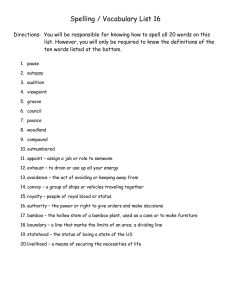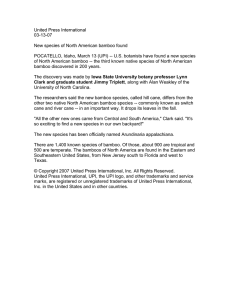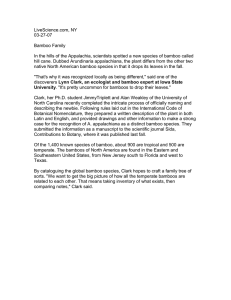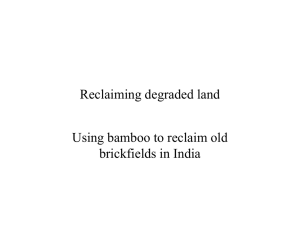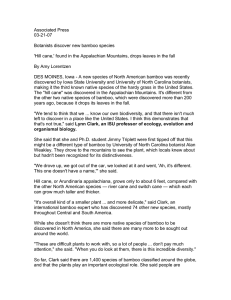Research Journal of Applied Sciences, Engineering and Technology 11(6): 571-577,... DOI: 10.19026/rjaset.11.2015
advertisement
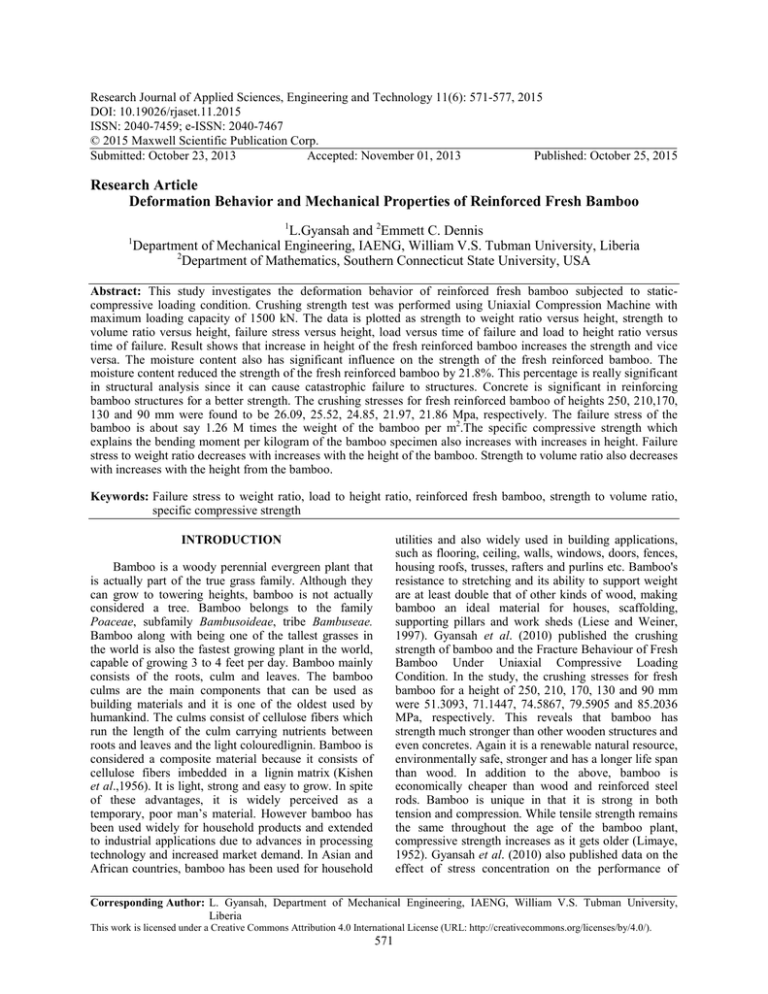
Research Journal of Applied Sciences, Engineering and Technology 11(6): 571-577, 2015 DOI: 10.19026/rjaset.11.2015 ISSN: 2040-7459; e-ISSN: 2040-7467 © 2015 Maxwell Scientific Publication Corp. Submitted: October 23, 2013 Accepted: November 01, 2013 Published: October 25, 2015 Research Article Deformation Behavior and Mechanical Properties of Reinforced Fresh Bamboo 1 1 L.Gyansah and 2Emmett C. Dennis Department of Mechanical Engineering, IAENG, William V.S. Tubman University, Liberia 2 Department of Mathematics, Southern Connecticut State University, USA Abstract: This study investigates the deformation behavior of reinforced fresh bamboo subjected to staticcompressive loading condition. Crushing strength test was performed using Uniaxial Compression Machine with maximum loading capacity of 1500 kN. The data is plotted as strength to weight ratio versus height, strength to volume ratio versus height, failure stress versus height, load versus time of failure and load to height ratio versus time of failure. Result shows that increase in height of the fresh reinforced bamboo increases the strength and vice versa. The moisture content also has significant influence on the strength of the fresh reinforced bamboo. The moisture content reduced the strength of the fresh reinforced bamboo by 21.8%. This percentage is really significant in structural analysis since it can cause catastrophic failure to structures. Concrete is significant in reinforcing bamboo structures for a better strength. The crushing stresses for fresh reinforced bamboo of heights 250, 210,170, 130 and 90 mm were found to be 26.09, 25.52, 24.85, 21.97, 21.86 Mpa, respectively. The failure stress of the bamboo is about say 1.26 M times the weight of the bamboo per m2.The specific compressive strength which explains the bending moment per kilogram of the bamboo specimen also increases with increases in height. Failure stress to weight ratio decreases with increases with the height of the bamboo. Strength to volume ratio also decreases with increases with the height from the bamboo. Keywords: Failure stress to weight ratio, load to height ratio, reinforced fresh bamboo, strength to volume ratio, specific compressive strength utilities and also widely used in building applications, such as flooring, ceiling, walls, windows, doors, fences, housing roofs, trusses, rafters and purlins etc. Bamboo's resistance to stretching and its ability to support weight are at least double that of other kinds of wood, making bamboo an ideal material for houses, scaffolding, supporting pillars and work sheds (Liese and Weiner, 1997). Gyansah et al. (2010) published the crushing strength of bamboo and the Fracture Behaviour of Fresh Bamboo Under Uniaxial Compressive Loading Condition. In the study, the crushing stresses for fresh bamboo for a height of 250, 210, 170, 130 and 90 mm were 51.3093, 71.1447, 74.5867, 79.5905 and 85.2036 MPa, respectively. This reveals that bamboo has strength much stronger than other wooden structures and even concretes. Again it is a renewable natural resource, environmentally safe, stronger and has a longer life span than wood. In addition to the above, bamboo is economically cheaper than wood and reinforced steel rods. Bamboo is unique in that it is strong in both tension and compression. While tensile strength remains the same throughout the age of the bamboo plant, compressive strength increases as it gets older (Limaye, 1952). Gyansah et al. (2010) also published data on the effect of stress concentration on the performance of INTRODUCTION Bamboo is a woody perennial evergreen plant that is actually part of the true grass family. Although they can grow to towering heights, bamboo is not actually considered a tree. Bamboo belongs to the family Poaceae, subfamily Bambusoideae, tribe Bambuseae. Bamboo along with being one of the tallest grasses in the world is also the fastest growing plant in the world, capable of growing 3 to 4 feet per day. Bamboo mainly consists of the roots, culm and leaves. The bamboo culms are the main components that can be used as building materials and it is one of the oldest used by humankind. The culms consist of cellulose fibers which run the length of the culm carrying nutrients between roots and leaves and the light colouredlignin. Bamboo is considered a composite material because it consists of cellulose fibers imbedded in a lignin matrix (Kishen et al.,1956). It is light, strong and easy to grow. In spite of these advantages, it is widely perceived as a temporary, poor man’s material. However bamboo has been used widely for household products and extended to industrial applications due to advances in processing technology and increased market demand. In Asian and African countries, bamboo has been used for household Corresponding Author: L. Gyansah, Department of Mechanical Engineering, IAENG, William V.S. Tubman University, Liberia This work is licensed under a Creative Commons Attribution 4.0 International License (URL: http://creativecommons.org/licenses/by/4.0/). 571 Res. J. App. Sci. Eng. Technol., 11(6): 571-577, 2015 bamboo using the notched and the un-notched specimen. In their research, it was obvious that the higher the notched angle within a bamboo, the lower the crushing loads. The variation in the notched angles also had significant effect on the crushing time. A notched-angle of 20, 30, 60, 80 and 90° gave a crushing load of 8.0, 5.55, 3.33, 1.33 and 0.93 kN, respectively and a crushing time of 42.46, 35.78, 21.89, 18.02 and 10.30 seconds, respectively, explaining the fact that the crushing time or time of failure of the bamboo decreases with increases in the notched angle. For this research work, the reinforcement to be used in the bamboo is concrete instead of the normal steel rods that are widely known in application in the construction industry. The importance of concrete in modern society cannot be underestimated. Look around you and you will find concrete structures everywhere in buildings, roads, bridges and dams. There is no escaping the impact concrete makes in everyday life. Concrete is a composite material which is made up of filler and binder. The binder (cement paste) glues the filler together to form a synthetic conglomerate. The constituents used for the binder are cement and water, while the filler can be fine or coarse aggregate. Cement and water are the two ingredients that do all the chemical reaction process. The gravel and sand give strength. The proportions of each ingredient (cement, sand, gravel and water) will determine how strong the concrete will be (Chudley,1994). Concrete essentially has a high level of compressive strength, while the tensile strength of concrete is relatively very weak. As concrete can crack under its own weight, it needs to be reinforced. It is generally reinforced using steel bars or fiber and iron mesh. To reduce the tensile strength of concrete, it is also pre-stressed with the use of steel cables. The deciding factor for strength is also inherently related to the proportion and ratio of water and cement, the type of cement used and the strength of used aggregate. The correct proportion of ingredients, placement and curing are needed in order for these properties to be optimal. Good-quality concrete has many advantages that add to its popularity. First, it is economical when inputs are readily available. Concrete's long life and relatively low maintenance requirements increase its economic benefits. Concrete is not as likely to rot, corrode, or decay as other building materials. Concrete has the ability to be molded or cast into almost any desired shape. Building of the molds and casting can occur on the work-site which reduces costs. Concrete is a non-combustible material which makes it fire-safe and able to withstand high temperatures. It is resistant to wind, water, rodents and insects. Hence, concrete is often used for storm shelters. Concrete does have some limitations despite its numerous advantages. Concrete has a relatively low tensile strength (compared to other building materials), low ductility, low strength-toweight ratio and is susceptible to cracking (Swamy, 2000). Despite all the numerous benefits of the applications of bamboo and concrete, accidents do occur with the use of this material as well as its general constructional usage. There are also certain limitations of the use of bamboo in construction. The starchy interior is attractive to insects. In addition, because bamboo has a slick waterproof coating, it cannot be painted. However, this coating allows bamboo to be used as water pipes. To determine the feasibility of again using bamboo to reinforce concrete, the problem is, however, that bamboo soaks up the water in the concrete, causing the bamboo to swell then shrink, the process of which can break the concrete. In addition, adhesion between the bamboo and the concrete is very poor (Maheshwari and Satpathy, 1988). The relative density of bamboo ranges between 0.5 and 0.8 g/cm3 (oven-dry weight). This value increases from the central parts to the peripheral parts of the culm and from the bottom to the top (Zhou, 1981). The studies on bamboos mechanical properties are commonly based on laboratory tests of the strength of bamboo (tensile strength, bending strength, compression strength, shear strength and modulus of elasticity) (Espiloy, 1987; Seema and Kumar, 1992). These tests show remarkable differing values when changing species, ages, moisture content, locations, soil and climatic conditions. The variation of mechanical properties is similar to wood, but even more remarkable. This is one of the reasons why bamboo is difficult to be used in the construction industry. However bamboo can be used as a plant in agro-forestry and in ornamental horticulture and also as an engineering material under various categories. The durability of bamboo depends strongly on the preservative treatment methods in accordance with basic requirements: its chemical composition should not have any effect on the bamboo fiber and once injected it must not be washed out by rain or humidity. The preservative can be applied using simple systems such as leave transpiration, immersion and impregnation (Ghavami and Rodrigues, 2000). A Composite in engineering sense is any materials that have been physically assembled to form one single bulk without physical blending to foam a homogeneous material. The resulting material would still have components identifiable as the constituent of the different materials. One of the advantages of composite is that two or more materials could be combined to take advantage of the good characteristics of each of the materials. Composites are made up of individual materials referred to as constituent materials. There are two categories of constituent materials: matrix and reinforcement. At least one portion of each type is required. The matrix material which in this case is bamboo surrounds and supports the reinforcement materials (concrete) by maintaining their relative positions. The reinforcements impart their special mechanical and physical properties to enhance the matrix properties (bamboo). A synergism produces 572 Res. J. App. Sci. Eng. Technol., 11(6): 571-577, 2015 compressive loading and to investigate into the effect of variation of length on the crushing strength of the composite material. Figure 1 shows bambusa vulgaris. MATERIALS AND METHODS Materials: The type of bamboo specie used for this research project is Bambusa vulgaris. This is because it is the most common type of bamboo specie in Africa and especially at the W.V.S. Tubman University’s campus. It can grow up to a height of 12 m and a thickness of 8 cm. This type of bamboo comprises the following; 5 starches, 2% deoxidized saccharide, 3 fat and 5.5% protein. The bamboo specimen involved both fresh reinforced with concrete with different lengths. The materials for concrete reinforcement within the bamboo specimen were cement, fine aggregate (sand), coarse aggregates (gravels) and water, measured in their right proportions. The size of the fine aggregate consisted of sand which is able to pass through a 5 mm BS sieve at the Mechanical Laboratory-W.V.S. Tubman University, whereas the coarse aggregate was also graded using sieve complying to BS 410:1976, the methods of test being outlined in BS 812: part 1:1975. Figure 2 shows the sectional view of the composite material. Fig. 1: Bambusa vulgaris material properties unavailable from the individual constituent materials, while the wide variety of matrix and strengthening materials allows the designer of the product or structure to choose an optimum combination. Engineered composite materials must be formed to shape. The matrix material can be introduced to the reinforcement before or after the reinforcement material is placed into the mould cavity or onto the mould surface. The matrix material experiences a melding event, after which the part shape is essentially set. Depending upon the nature of the matrix material, this melding event can occur in various ways such as chemical polymerization or solidification from the melted state (Lakkad and Patel, 1980). The physical properties of composite materials are generally not isotropic (independent of direction of applied force) in nature, but rather are typically orthotropic (different depending on the direction of the applied force or load). For instance, the stiffness of a composite panel will often depend upon the orientation of the applied forces and/or moments. Panel stiffness is also dependent on the design of the panel. For instance, the fibre reinforcement and matrix used, the method of panel build, thermo set versus thermoplastic, type of weave and orientation of fibre axis to the primary force. In contrast, isotropic materials (for example, aluminium or steel), in standard wrought forms, typically have the same stiffness regardless of the directional orientation of the applied forces and/or moments (Lakkad and Patel, 1980). The relationship between forces/moments and strains/curvatures for an isotropic material can be described with the following material properties: Young's Modulus, the Shear Modulus and the Poisson's Ratio, in relatively simple mathematical relationships. For the anisotropic material, it requires the mathematics of a second order tensor and up to 21 material property constants (Gere and Timoshenko, 1998). Therefore for the purposes of design and reliability, it is imperative to study and understand the behaviour of reinforced fresh bamboo subjected to uni-axial compressive loading. In this project, emphasis will be on fresh reinforced bamboo (composite material) subjected to Uni-axial compressive loading using the Uni-axial compression testing machine. The researchis also conducted to study the behaviour of reinforced bamboo under uni-axial Sample preparation: Fresh bamboos as received from the forest were free from insect infestation. They were then dried for two weeks at a temperature range of 3033°C and cut into the needed lengths such as 250, 21, 170, 130 and 90mm with a cross-cut saw (i.e., interval of 40 mm). The dried bamboo specimens were then polished with P 1200, P 600, P 400, P 240, P 180 Abrasive paper. Thesespecimens were carefully cut such that, the node lies at the center of the height. The external and internal diameters “Do and Di”(i.e., Fig. 3b Schematic Diagram of Bamboo) were measured using a micrometer screw gauge and found to be between 82 to 86mmandalso between 72 to 74mm, respectively. The specimens were finally weighed on a scale as shown in Fig. 3a. Uni-axial compressive test: This test was carried out using the equipment known as the Uni-axial Compression Machine at room temperature. The experiment involves placing the specimens on the lower platen of the compressive testing machine with maximum loading capacity of 1500 kN and crushing them to know the compressive load. The fresh bamboo specimens were weighed in order to take their initial weight as mass of dried bamboo (WD) and mass of fresh bamboo (WF), respectively before filling with concrete. This is necessary to help in the determination of the moisture content of the specimens. The bamboo samples were then filled with concrete paste of ratio 1: 3: 6 and allowed for a week to dry. The weight of the dried 573 Res. J. App App. Sci. Eng. Technol., 11(6): 571-577, 2015 specimens used for this analysis were from the same culm and thus were weighed to record their initial weights before filling with concrete. According to Head (1992), the moisture content formula is given as: Moisture Content (MC%) = – × 100% (1) where, MC% = The moisture content of fresh reinforced bamboo specimen = The Mass of fresh reinforced bamboo WF WD = The Mass of dried reinforced fresh bamboo Fig. 2: Sectional view of the composit composite material (i.e., reinforced bamboo specimen) RESULTS AND DISCUSSION Experimental results are shown in Table 1 to 3. Five specimens of the same height were crushed and for the sake of accuracy of results, average loads of failure were calculated. For instance, for a height of 250mm,five specimens of height 250mm were crushed and average load of failure was calculated. A similar procedure was followed for the heights of specimen of 210,170, 130 and 90mm for fresh reinforced bamboo specimen. From Table 1 it could be seen that the strength (load of failure) increases with increases in the height or the strength increases as the height increases. This is due to the fact that the concrete gave additional strength to the bamboo. Therefore, concrete is significant in reinforcing re bamboo structures for a better strength. The moisture content also has significant influence on the strength of the fresh reinforced bamboo. Using Head (1992), the moisture content reduced the strength of the fresh reinforced bamboo by 21.8%. Thiss percentage is really significant in strength analysis since it can cause catastrophic failure to structures. From Table 3, it is clear that the average failure stresses also increases with increases in height of the specimens. ushing stresses were All the failure stresses/crushing computed using equations (3) and (4) (Fig. 5). According to Gere and Timoshenko (1998), the stress that caused the reinforced bamboo specimens to fail is the total compressive stress ( ): Fig. 3a: Fresh reinforced bamboo on a scale Fig. 3b: Schematic diagram of bamboo = (2) where, Stress due to Concrete (σc) = Fig. 4: Fresh reinforced bamboo under compressive test Stress due to Bamboo (σB) = concrete were weighed again to know the overall weight of the reinforced fresh bamboo; with (W W1) as weight of reinforced fresh bamboo. Figure 4 shows reinforced fresh bamboo sample under crushing strength test. where, (E) = (EC) = (EB) = (PL) = (AB) = (AC) = Moisture content analysis: This was performed to know the effect of moisture content on the compressive strength of the fresh reinforced bamboo. All the 574 (3) (4) Modulus of Elasticity Modulus of Elasticity for Concrete = 17GPa Modulus of Elasticity for Bamboo = 11GPa Load of failure Cross-Sectional Sectional Area of Bamboo Samples Cross-Sectional Sectional Area of Concrete Samples Res. J. App. Sci. Eng. Technol., 11(6): 571-577, 2015 Table 1: Results for fresh reinforced bamboo specimen Specimen type Fresh Fresh Fresh Fresh Fresh Average Fresh Fresh Fresh Fresh Fresh Average Fresh Fresh Fresh Fresh Fresh Average Fresh Fresh Fresh Fresh Fresh Average Fresh Fresh Fresh Fresh Fresh Average Length (mm) 250.0 250.0 250.0 250.0 250.0 250.0 210.0 210.0 210.0 210.0 210.0 210.0 170.0 170.0 170.0 170.0 170.0 170.0 130.0 130.0 130.0 130.0 130.0 130.0 90.0 90.0 90.0 90.0 90.0 90.0 External Diameter Do (mm) 86.00 86.00 86.00 86.00 86.00 86.00 85.00 85.00 85.00 85.00 85.00 85.00 84.00 84.00 84.00 84.00 84.00 84.00 84.00 84.00 84.00 84.00 84.00 84.00 82.00 82.00 82.00 82.00 82.00 82.00 Internal Diameter-Di (mm) 74.00 74.00 74.00 74.00 74.00 74.00 73.00 73.00 73.00 73.00 73.00 74.00 72.00 72.00 72.00 72.00 72.00 72.00 72.00 72.00 72.00 72.00 72.00 72.00 71.00 71.00 71.00 71.00 71.00 71.00 Load of failure (kN) 84.00 83.00 85.00 82.00 84.00 83.60 80.00 82.00 79.00 80.00 81.00 80.40 76.00 77.00 72.00 75.00 79.00 75.80 68.00 65.00 63.00 70.00 69.00 67.00 60.00 64.00 59.00 64.00 67.00 62.80 Table 2: Summary results for fresh reinforced bamboo-part 1 Height of fresh External Internal Mass of only bamboo diameter diameter bamboo (mm) (mm) (mm) (g) 250.00 86.00 74.00 516.96 210.00 85.00 74.00 421.97 170.00 84.00 72.00 364.54 130.00 84.00 72.00 258.05 90.00 81.00 71.00 193.04 Mass of bamboo (WF) (g) 516.90 521.54 512.65 519.40 514.29 516.96 420.60 432.07 418.67 422.60 415.89 421.97 366.6 371.3 362.7 364.9 357.2 364.54 257.90 258.20 261.40 253.70 259.01 258.05 193.70 194.60 192.50 190.90 193.50 193.04 Mass of reinforced bamboo (W1)(g) 2830.30 2187.50 1757.20 1314.60 926.10 Mass of reinforced bamboo (W1)(g) 2830.30 2785.98 2635.56 2819.02 2677.43 2749.66 2187.50 2157.89 2179.43 2189.51 2121.99 2167.26 1757.00 1755.32 1723.89 1745.67 1769.42 1750.26 1314.60 1344.21 1320.32 1322.45 1312.43 1322.80 926.10 932.14 919.79 937.12 916.66 926.36 Mass of only concrete (g) 2313.34 1765.53 1392.66 1056.55 733.06 Volume of the reinforced bamboo (m3) 1.45×10-3 1.45×10-3 1.45×10-3 1.45×10-3 1.45×10-3 1.45×10-3 1.19×10-3 1.19×10-3 1.19×10-3 1.19×10-3 1.19×10-3 1.19×10-3 9.42×10-4 9.42×10-4 9.42×10-4 9.42×10-4 9.42×10-4 9.42×10-4 7.21×10-4 7.21×10-4 7.21×10-4 7.21×10-4 7.21×10-4 7.21×10-4 4.75×10-4 4.75×10-4 4.75×10-4 4.75×10-4 4.75×10-4 4.75×10-4 Average load of failure (kN) 83.60 80.40 75.80 67.00 62.80 Density of reinforced bamboo (kg/m3) 1948.51 1920.69 1817.24 1944.14 1846.21 1895.36 1837.82 1812.61 1831.09 1839.50 1782.35 1820.67 1864.74 1863.06 1829.09 1877.92 1877.92 1862.55 1823.67 1864.10 1830.80 1833.60 1819.70 1834.37 1948.03 1962.11 1934.74 1972.63 1928.42 1949.19 Time of failure (Seconds) 57:62 48:92 39:77 35:02 29:71 Table 3: Results for fresh reinforced bamboo-part 2 Height (mm) 250.00 210.00 170.00 130.00 90.00 External diameter (mm) 86.00 85.00 84.00 84.00 82.00 Internal diameter (mm) 74.00 74.00 72.00 72.00 71.00 Area of concrete (Ac) (mm2) 4300.84 4300.84 4071.50 4071.50 3959.19 Area of bamboo (AB) (mm2) 1507.96 1373.66 1470.27 1470.27 1193.81 Average load of failure (kN) 83.60 80.40 75.80 67.00 62.80 Average failure stress (MPa) 26.09 25.52 24.85 21.97 21.86 The failure stress of the bamboo is about say 1.26 M times the weight of the bamboo per square meter (Table 3). From Fig. 6, it is clear that the average load with which the fresh reinforced bamboo failed increases as the height of the bamboo increases. At a height of 250mm the average load of failure for fresh reinforced bamboo is 83.60kN. Time of failure (Seconds) 57:62 48:92 39:77 35:02 29:71 Failure stress to weight ratio (1/m2) 0.97 M 1.20 M 1.45 M 1.70 M 2.40 M Specific Load to height compressive strength ratio (KN·m/kg) (KN/m) 334.40 13.717 382.86 13.602 445.90 13.342 515.38 11.977 688.89 11.215 Strength to volume ratio (MPa/m3) 17993.10 21445.38 26380.04 30471.57 46021.05 The specific compressive strength which explains the bending moment per kilogram of the reinforced bamboo specimen also increases with increases in height. This is shown in Fig. 7. Failure stress to weight ratio (i.e., Fig. 8 decreases with increases with the height of the bamboo. This makes emphasis on the stress per unit area of the bamboo specimen. 575 27 Fresh reinforced bamboo Crushing stress (MPa) 26 Failure stress to weight ratio (M/m 2 ) Res. J. App. Sci. Eng. Technol., 11(6): 571-577, 2015 26.09 25.52 24.85 25 24 23 21.86 21.97 22 21 :48 Time of failure (S) Fresh reinforced bamboo 80.4 75.8 1.5 1.0 0.5 0 0.0 0.1 0.3 0.2 700 Load to height ratio 83.6 67 Fresh reinforced bamboo 600 550 500 450 400 350 300 4:4 8 48 38 58 Fig. 9: Load to height ratio versus time 1.0 0.5 7 :3 6 0.5 0:2 4 0.4 3:1 2 28 0.3 6 :0 0 Load (kN) 8:4 8 0.2 2.0 650 Strength to volume ratio (MPa/m3) Time of failure (S) Fig. 6: A graph of load versus time of failure 14.0 2.5 Fig. 8: Failure stress to weight ratio versus height Fig. 5: A graph of crushing stress versus time of failure 90 85 80 75 70 65 62 60 55 50 45 40 Fresh reinforced bamboo 1.0 4 0.5 7:3 6 0.5 0:2 4 3:1 2 0.4 0.3 6:0 0 0.2 8 :48 20 3.0 Specified compressive strength (fresh reinforced bamboo) 13.5 13.0 12.5 12.0 Fresh reinforced bamboo 46000 41000 36000 31000 26000 21000 16000 85 135 185 235 285 11.5 11.0 0.05 0.15 Fig. 10: Strength to volume ratio versus height 0.25 Hight (m) • Fig. 7: Specific compressive strength versus height • Load to height ratio also decreases with increase with the height of the bamboo. This explains the load of failure per meter of the bamboo specimen (Fig. 9). Strength to volume ratio also decreases with increases with the height from the bamboo (Fig. 10). It signifies stress per meter cube of the bamboo specimen. • CONCLUSION • The following conclusions were arrived at after the crushing tests experiment and moisture content analyses were performed: • 576 Increase in height of the reinforced bamboo increases the strength and vice versa. The failure stress of the bamboo is about say 1.26 M times the weight of the bamboo per square meter. The specific compressive strength which explains the bending moment per kilogram of the bamboo specimen also increases with increases in height. Failure stress to weight ratio decreases with increases with the height of the bamboo. The moisture content also has significant influence on the strength of the fresh reinforced bamboo. Res. J. App. Sci. Eng. Technol., 11(6): 571-577, 2015 • • • • Ghavami, K. and C.S. Rodrigues, 2000. Engineering materials and components with plants. Proceeding of the CIB Symposium on Construction and Environment, Theory into Practice. São Paulo, Brazil, CD-ROM, Global Seven Editor, pp: 1-16. Gyansah, L., A.S. Akinwonmi and M. Affam, 2010. The fracture behaviour of fresh bamboo under uniaxial compressive loading condition. Res. J. Appl. Sci. Eng. Technol., 2(8): 721-726. Head, K.A., 1992. Manual of Soil Laboratory Testing, Soil Classification and Compaction Test. 2nd Edn., Pentech Press, London, pp: 68-76. Kishen, J., D.P. Ghosh and M.A. Rehman, 1956. Studies on moisture content, shrinkage, swelling and intersection point of mature (Dendrocalamus strictus) male bamboo. Indian Forest Rec., 1: 1-30. Lakkad, S.C. and J. M. Patel, 1980. Mechanical properties of bamboo: A natural composite. Fiber Sci. Technol., 14: 319-322. Liese, W. and G. Weiner, 1997. Modifications of Bamboo Culm Structures Due to Ageing and Wounding. The Linnean Society, London, pp: 313-322. Limaye, V.D., 1952. Strength of bamboo (Dendrocalamus strictus). Ind. For. Rec., 78: 558-575. Maheshwari, S. and K. Satpathy, 1988. Pulp and papermaking characteristics of nodes, internodes and culm of bamboo Dendrocalamus strictus. IPPTA, 25: 15-19. Seema, J. and R. Kumar, 1992. Mechanical behaviour of bamboo and bamboo composite. J. Mater. Sci., 27: 4598-4604. Swamy, R.N., 2000. Sustainable concrete for infrastructure regeneration and reconstruction. Proceeding of the International Conference on Sustainable Construction into the Next Millennium Environmentally Friendly and Innovative Cement Based Materials. Joao Pessoa, Brazil, pp: 15-44. Zhou, F.C., 1981. Studies on physical and mechanical properties of bamboo woods. J. Nanjing Technol. Coll. Forest Prod., 2: 1-32. The moisture content reduced the strength of the fresh reinforced bamboo by 21.8%.This percentage is really significant in structural analysis since it can cause catastrophic failure to structures. Strength to volume ratio also decreases with increases with the height from the bamboo. That means stress per meter cube of the bamboo specimen. Concrete is significant in reinforcing bamboo structures for a better strength. The crushing stresses for fresh reinforced bamboo of heights 250,210,170,130 and 90mm were found to be 26.09,25.52, 24.85,21.97,21.86 Mpa, respectively. . RECOMMENDATIONS It is recommended that: • • Construction companies and industries in Ghana, Liberia and Africa in general should be encouraged to use bamboo as an alternative to timber for structural purposes in order to reduce the depletion of our forest reserve. Reinforced fresh bamboo has significant strength and is hence, recommended for construction industry in Africa. ACKNOWLEDGMENT Authors are also thankful to the management of the mechanical laboratory of the W.V.S. Tubman University, Liberia. REFERENCES Chudley, R., 1994. Concrete: Construction Technology. 2nd SI Edn., ELBS with Longman (Publishers) Ltd., 1: 20-24. Espiloy, Z.B., 1987. Physico-mechanical properties and Anatomical relationships of some Philippine bamboos. Proceeding of the International Bamboo Workshop. Hangzhou, P.R. China, 1: 257-264. Gere, J.M. and S.P. Timoshenko, 1998. Mechanics of Machines. 3rd SI Edn., S. Thornes (Publishers) Ltd., Cheltenham, pp: 761. 577
